(contains spoilers for Paris, Texas)
Now available in video essay form, here: https://www.youtube.com/watch?v=GLt5Q6UqNZc
Synopsis
Paris, Texas is a 1984 drama directed by Wim Wenders, winning the Palme d’Or at Cannes that year. I briefly mentioned this before, on a post about my Criterion Collection. It’s the story of a man named Travis, played by Harry Dean Stanton, who we meet wandering in the Texas desert, at the point of collapse. He is picked up by his brother Walt (Dean Stockwell), who takes him to Burbank, where Walt lives with his wife Anne, and Travis’ 7 year old son, Hunter. Travis has not had any contact with or seen Walt, Hunter or Anne in over 4 years, and so Hunter doesn’t really know Travis at all, but the two begin to bond, and decide to travel to Houston to track down Hunter’s mother, Jane (Nastassja Kinski).
In Houston, Travis finds Jane working at a peep-show, and it’s in this setting, communicating through telephone and loudspeaker, with Jane unable to see Travis through the two-way mirror, that Travis tells Jane a story, tells her his story. The whole scene lasts around 20 minutes, which sounds like a lot of exposition, but what we see tells us just as much as what we hear. And that’s the point of this post really, just to dig deep into a great scene from a great film, analyse and uncover the things we might not have noticed directly, but our brains certainly did subliminally.
If you need a refresher, the sequence is in YouTube in two parts, here:
Analysis
First, let’s take the sequence as a whole. It’s 19 minutes and 55 seconds long, but contains only 22 shots. That’s an average of 54.3 seconds per shot, and as we will see, some shots last for much longer than that. The average shot in this sequence is much longer than usual, even for a drama film. So, we as the audience become more aware of and place more importance on each cut, and the length of time we spend looking at the same shot means we are encouraged to take in every detail,to study each character’s movements and mannerisms.
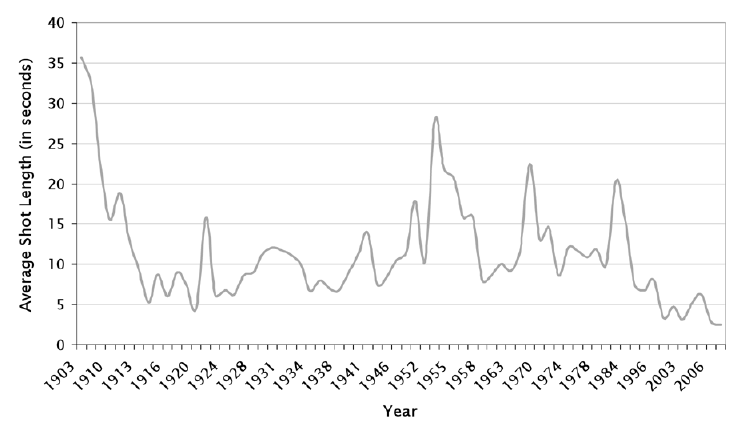
So onto the first shot, which establishes the setting. A room split in two. Travis’ side is dark, containing only a telephone and a small lamp. The first few seconds of the shot show Travis sitting in the dark, phone to his ear, looking at his reflection in the darkness. We don’t know how long he has been waiting at this point, but Jane quickly enters and turns on the lights on her side. Jane’s side is much lighter, it has a window which seems to be letting in sunlight (though obviously it’s artificial), there’s a plant, and light coloured fixtures and furnishings. Jane’s side gives the impression of life and light, however artificial, while Travis’ side is characterised by darkness. There is a two-way mirror separating each side, through which Travis can see Jane, but Jane can only see her own reflection. Above the mirror, is a small, drab sign, reading “Coffee Shop”. The angle of the shot is such that we are positioned on Travis’ side, looking at Jane through the two-way mirror, an accomplice in the voyeurism of the room’s set-up. When Jane first enters and sits down, her position and choice of black costume mean Travis is reflected back to us through her. Is it that Travis sees himself and his past in Jane when he looks at her? Is it that Travis is a part of Jane? Or maybe it’s a little of both. In any case, we can see that the two are intimately connected.
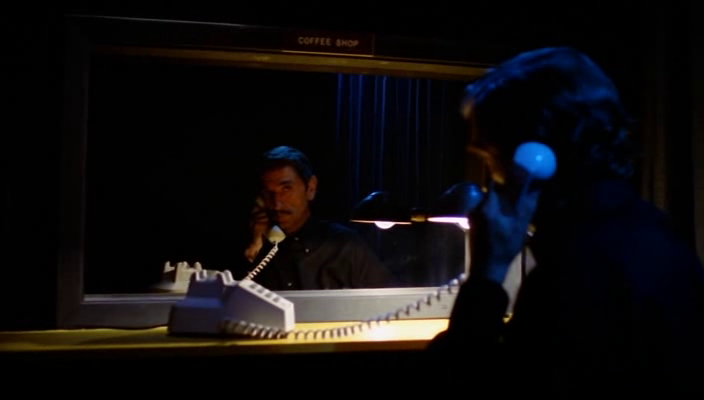
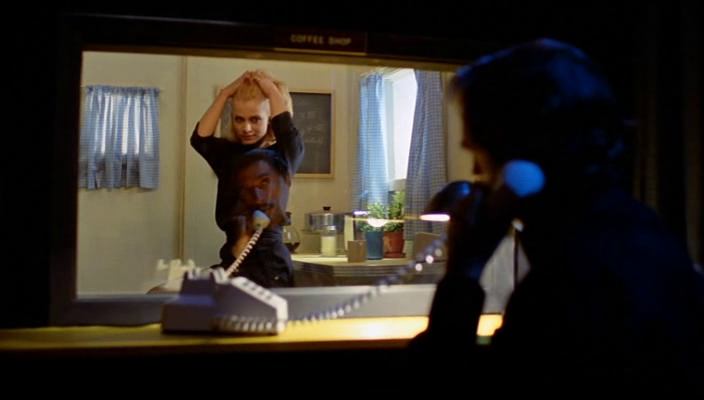
Travis turns away from Jane and begins to tell his story. At first, we see both Travis and Jane, with Travis starting his story (“I knew these people…”), and Jane politely responding (“What people?”). Soon, the camera moves slowly to Travis until only he is framed in a medium-close up. Travis describes the two characters of his story, the older, “raggedy and wild” man, and the younger, “very beautiful” woman. It’s when Travis says “…and she was very beautiful, you know?” that we have our first cut, after 83 seconds. We cut from the medium close-up of Travis, to a medium shot of Jane, as seen through the peep show window (the top edge of the window frame can be seen, as well as some faint reflections of blue curtains).

We cut to her at this time as if to appraise and acknowledge her beauty for ourselves. Looking at Jane through the window maintains a sense of distance, as if observing her like the clients of the peep show might. We are still entirely in Travis’ side of the room, and have not yet pierced through to become close to Jane. Travis continues his story, and the camera lingers on Jane through the window for around 20 seconds. The film cuts between Jane and Travis, slowly and deliberately. The first two shots of Jane are from behind the glass, with the window frame and some reflections visible, but the third shot of Jane diminishes the sense of distance a little bit.

We are still viewing Jane as if from Travis’ side of the room through the window, but it is much clearer than previously (no window frame or reflections). There is still a sense of distance though, emphasised by Jane’s voice, which is still heard as if through a mechanical speaker, and the camera angle placing us on Travis’ side of the room. It seems as though this distance is shortening though, with Jane perhaps becoming more and more aware of who she is talking to, and we are given a great deal of time to judge her demeanour and reactions to the story she is being told, since this shot lasts over a minute.
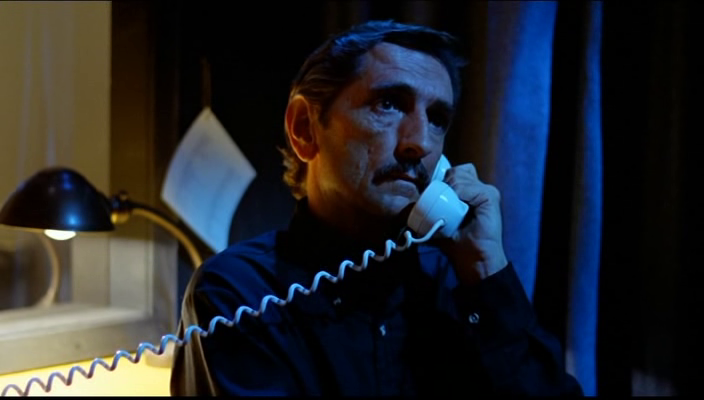
The next couple of shots follow a similar pattern, but are paced much more quickly, with just a few seconds between shots. Travis’ story continues, and we cut between Travis and Jane, until Travis mentions the couple of his story lived in a trailer. At this point, we cut to Jane for a reaction, but the camera is now firmly on her side of the room, a medium-close up of Jane’s face. This is also the first time we hear Jane’s natural voice, free of the mechanical, tinny distortion placed on it by the speaker we had heard it through previously, as she asks, in a whisper, “A trailer…?”

This shot is only held for 4 seconds or so, before cutting to Jane again, in medium-long shot, with her shown in full in the mirror. The artifice of the room is in full view here, with insulation and foil visible surrounding the double-mirror window. She is unable to see Travis through the mirror, but it’s dawning on her that she is looking at, and hearing, her own past, which of course is emphasised by the fact of her staring at her own reflection. Travis answers Jane, “Yes, they lived in a trailer home”, and his voice is heard through the speaker, emphasising that we have crossed the divide into Jane’s side of the room, and we are given a little time to try and scrutinise Jane’s reaction to this, as she looks into the mirror.

A little distance is re-established in the next shot however, cutting back to Travis in the foreground on phone, with Jane in the background seen through the window. Jane asks if Travis had visited as a customer recently, a business-like aside, addressing him as “Sir”, before primly asking him to “Please, go on” with his story after he denies this. Again, we are back on Travis’ side of the room, and Jane’s voice has gone back to being heard through the tinny speaker, as before. After around 75 seconds, we cut back to Jane, again in close-up again on Jane’s side, as Travis continues with his story.

It’s clear Jane is back to contemplating the story, reconciling it with her own past, but initially it is unclear if she has yet confirmed the connection in her mind. It soon becomes very clear however that the story is resonating with her, as tears form and fall, and the music begins lightly around 30 seconds into this shot. All we hear is Travis’ voice coming through the tinny speaker, the soft music, and Jane’s breathing and brief, suppressed sobs and sniffs. This shot holds for just over 3 minutes, ample time to scrutinise every facial movement and reaction of Jane, to try and untangle how she is feeling, if she realises who she is listening to, and to try and work out the moment the realisation hits and there is no longer any doubt.
The next 4 shots return to the Travis -> Jane -> Travis -> Jane pattern, moving from one side of the mirror divide to the other, Travis speaking, and Jane reacting. After the 4th shot in this pattern though, we cut from the close-up of Jane, to a mid shot of Jane, still on her side of the mirror, but showing Jane reflected in the mirror, we see what she sees.
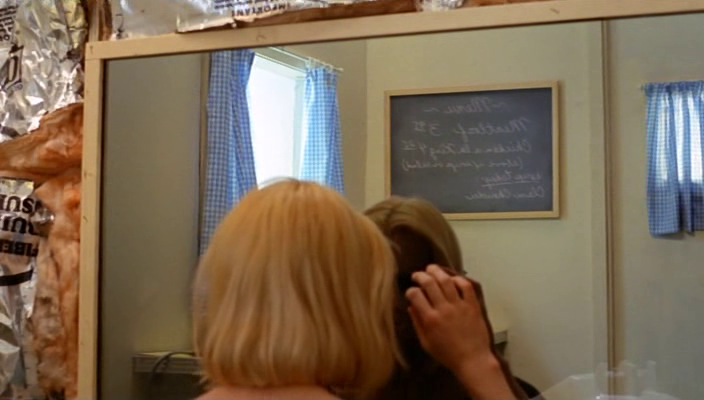
Again we can note the artifice of the setting, with insulation in view, but we are closer than the previous mirror-shot. Jane begins to move towards the mirror, gently calling “Travis…”, and there become two Janes, mirror-Jane and real-Jane. The two Janes meet at the mirror, the barrier through which lies Jane’s past, Travis. From here we cut to a close-up of Travis, who slowly turns to face Jane, and by extension his past. Then, still on Travis’ side of the room, we cut to Jane again, In close-up and peering through the window. It’s notable that at this cut, the music stops, returning again just to the sounds of Travis and Jane.
The shot following this shows Travis turning fully, moving his chair to position himself in front of Jane. We only see his movement through his reflection in the window, and when he is fully turned round and seated in front of Jane, his reflection joins with hers, becoming one.
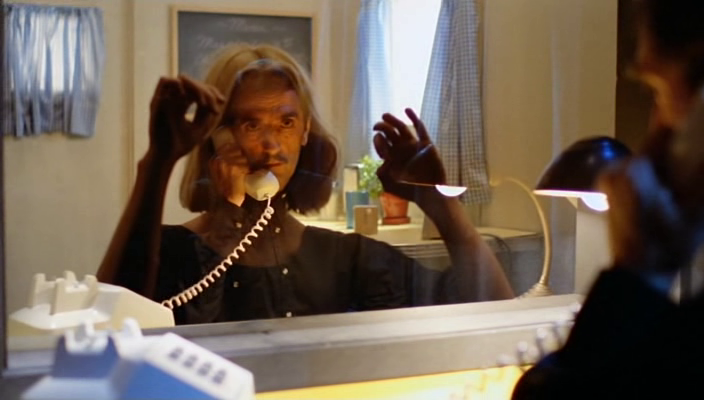
There is a great deal of mythology and the spiritual present in this sequence, both in the construction of the setting (an artificial cafe, set up to present the myth of meeting a girl in a pleasant, public place) and in the story itself. The imagery in Travis’ story helps us register it as symbolic and mythological. When Travis talks of the man tying a bell to the woman’s leg to hear her movements and her stuffing it with a sock, it seems like something you might hear in a fairy tale of a tyrant and princess, and when he talks of running through the flames to escape his trailer and continuing to run without looking back, it’s symbolic of the purging of his previous life and memories and the avoidance of his problems since then. In terms of the film as a whole it harkens back to Travis’ aimless wanderings in the desert, itself a reimagining of the mythological lone cowboy of the US frontier, but instead of exploring as yet undiscovered territory Travis is avoiding exploration of his own psyche and issues. At this point, Travis has finished his story, Jane has realised who she has been talking with, and the two are, after a fashion, reunited. It is notable though that the two never physically touch, only their reflections do. It is a spiritual reawakening, a catharsis and realignment enacted through the power of storytelling. Now, it is Jane’s turn.
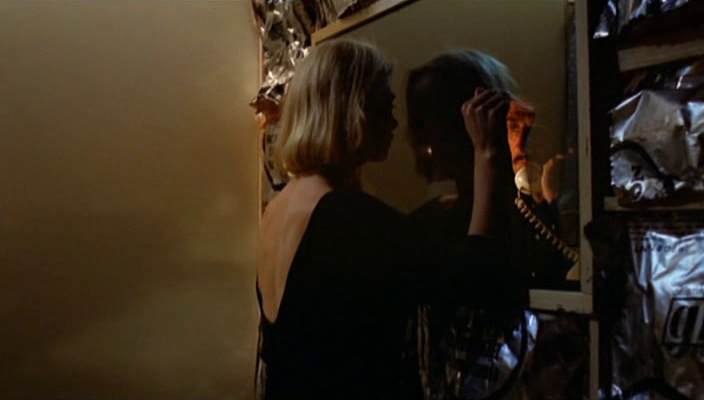
Jane goes to turn off the lights in an attempt to see Travis, and we cut to a mid shot of the two, face to face through the glass, with Travis’ illuminated in a warm yellow light, rather than the cold blue we had been seeing him in previously. Travis tells Jane that he has brought their son Hunter, and where Jane can find him, and moves to leave, but Jane stops him, telling him “Don’t go yet…”. Then, in a similar fashion as Travis did before, Jane turns away, and gets ready to tell her own story. The camera follows her as she turns, before settling with Jane at the bottom of the frame, Travis looking on at the top.

Again, we have a long lasting static shot while Jane tells her story, around 4 minutes long. She tells Travis how she used to talk with him every day after they left each other, having whole conversations in her own head, but now is at a loss as to what to say. We are given plenty of time to study each of their faces as she turns and sits beneath the window, telling her story through the microphone as Travis sits, still as a stone and inscrutable, listening. What we get from her story is that their past was very important, for both of them, but now they must let go of it, of the hold they had on each other, and stop running away. She tells Travis she will go to Hunter, and then she and Travis get up to leave, separately, and go onward on their own, separate paths. We see Jane exit through the reflection on the window, turning on the light and reestablishing the artificial cafe setting as she does so. After Jane turned from Travis to tell her story, the two never look at each other directly again. And so the sequence ends, having begun in the dark and finishing in light.
This sequence is essentially just a 20 minute (at times one-sided) conversation, but it is so rich in mythology and meaning, created through the story itself, camera choices, sound, music, and of course the editing. It’s cut in a recognisable conversational shot-reverse shot kind of style, but with a deliberate and slow pace, with plenty of time for reflection and study of our character’s reactions (mostly Jane’s). It breaks the pattern at important points as well, like crossing into Jane’s side of the room, or cutting from Jane to Jane’s reflection.
While the cutting is slow, it never feels languid or without energy, but in fact focuses our attention. It is a bewitching and engrossing sequence, and one that lives long in the memory.


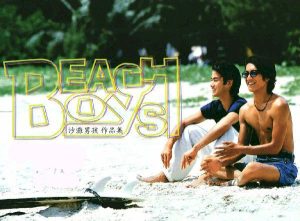









One Response
What a wonderful synopsis. Thank you. I love this movie so much and this monologue is outstanding. You’ve helped me understand why it moves me so much.